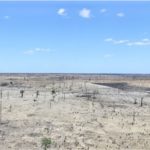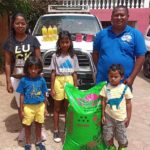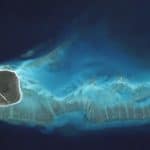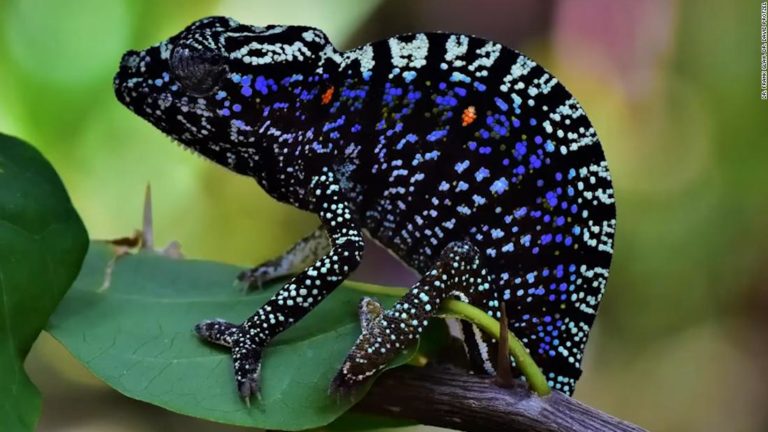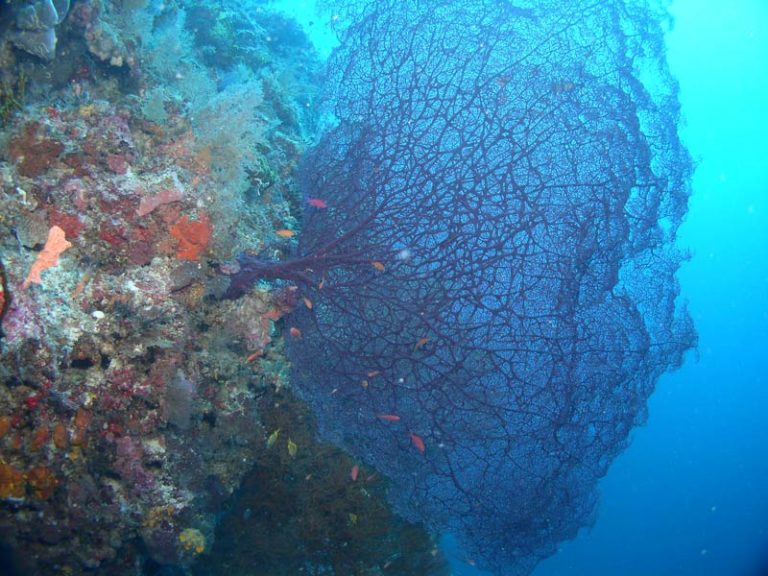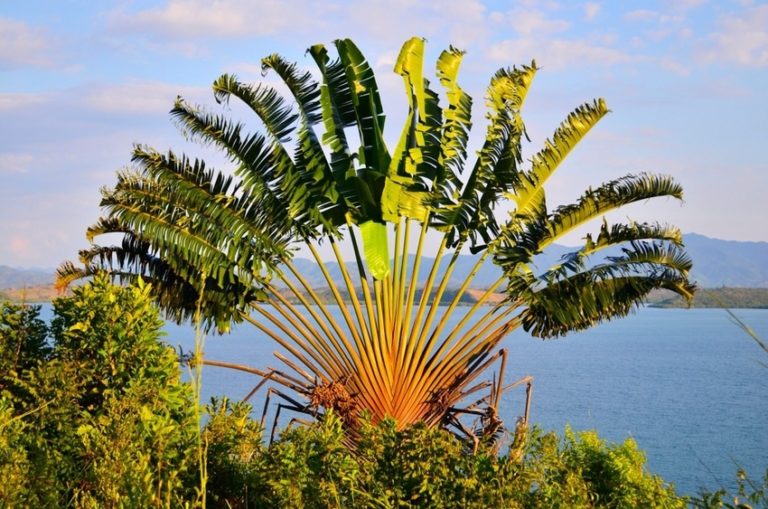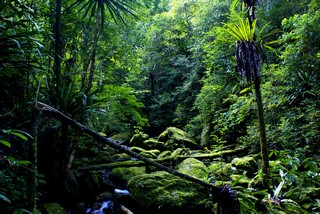Amphibians in Madagascar
Part 1 - Hyperoliidae, Mantellidae
Part 2 - Microhylidae and Ranidae.
The peculiarity of the amphibians in Madagascar is that almost all of the approximately 200 frog species are endemic there.
According to the estimates of two specialists of the amphibian world of Madagascar, Frank Glaw and Miguel VencesHowever, the affiliation of more than 150 of the frogs is not yet clear.
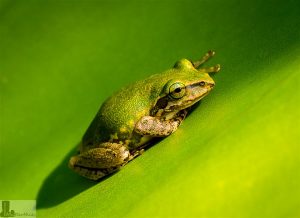
The Mantella Group is the most endangered group of amphibians in Madagascar.
The Mantella crocea are now represented by only a small group of 500 individuals. Other species of this group are more common.
Mantella laevigata is often found in the Marojejy National Park and on Nosy Mangabe;
Mantella betsileo come from the nature reserve Lokobe and Mantella madagascariensis can be found between the leaves of eucalyptus trees near Vohiparara Ranomafana.
With a total length of 10 to 12 mm and a weight of only 0.2 mg, the species is Sumpffia pygmaea the smallest frog in the world.
This species lives in the Ylang ylang plantation in Nosy Be, but can also be found along roadsides or on wet forest floors, hidden among the leaves.
Among the Tomato frogs are two species: Dyscophus antongilii and Dyscophus guineti. 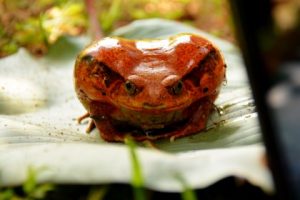
These two species are among the largest frogs in Madagascar.
Among the most beautiful and colorful frogs of Madagascar, in addition to the two species already mentioned, are the golden Mantellas also the Microhylidae of the genus Scaphiophryne.
Particularly attractive is the type Scaphiophryne gottlebei, which is located in the region of the Isalo National Parks lives.
Unfortunately, because of its bright color, it is threatened by the amphibian trade.
Therefore, the beauty of this frog species is fatal for them. The environmental protection organization Pro Wildlife draws attention to the danger of liquidation of Madagascar's biodiversity.
The legal ban on trade in endangered amphibian and reptile species was discussed in the Species Survival Commission of the Washington Convention on International Trade in Endangered Species as early as 2009.
The Amphibian population of Madagascar is composed exclusively of frogs. There are 311 named frog species in Madagascar, but several hundred have been identified by DNA barcoding and have yet to be formally described.
Native described species belong to four different families: Hyperoliidae (11 species), 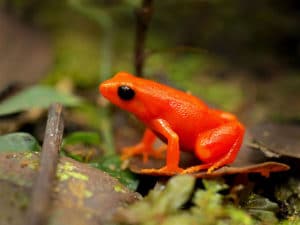
Two other species are introduced: the ranide Frog Hoplobatrachus tigrinus and the Toad Duttaphrynus melanostictus.
Almost all native species are endemic, with the exception of Ptychadena mascareniensis. 85 species are threatened with extinction, nine of which are classified as critically endangered by the IUCN.
Their numbers are largely affected by severe habitat changes due to deforestation and expansion of rice fields and villages, and to a lesser extent by illegal international trade.
Hyperoliidae
The Hyperoliidae, or sedge and shrub frogs., are a large family of small to medium-sized, colorful frogs that includes more than 250 species in 19 genera.
In addition, the genus Heterixalus (currently 10 species) is endemic to Madagascar.

Most Hyperoliids are arboreal, but some are terrestrial. The dietary habits are very different.
Reproduction in this family begins at the beginning of the rainy season, when hyperoliids congregate at breeding sites.
Most hyperoliids lay their eggs in water, although foam nests, tree hole incubation, and oviposition in vegetation above water are known.
Afrixalus builds leaf nests for its eggs by folding and gluing the leaf edges. Tadpoles are pond-like larvae with large dorsal fins on their tails.
Heterixalus alboguttatus
Heterixalus alboguttatus is a species of frog in the Hyperoliidae family endemic to Madagascar.
Its natural habitats are subtropical or tropical moist lowland forests, subtropical or tropical moist shrublands, subtropical or tropical seasonally moist or flooded lowland grasslands, swamps, freshwater marshes, intermittent freshwater marshes, croplands, severely degraded former forests, ponds, irrigated lands, and seasonally flooded agricultural lands.
Heterixalus andrakata
Heterixalus andrakata is a species of frog in the family Hyperoliidae endemic to Madagascar. Its natural habitats are subtropical or tropical moist lowland forests, subtropical or tropical seasonally moist or flooded lowland grasslands, swamps, freshwater marshes, intermittent freshwater marshes, urban areas, heavily degraded former forests, ponds, irrigated lands, and seasonally flooded agricultural lands.
Heterixalus betsileo
Heterixalus betsileo is a species of frog in the Hyperoliidae family endemic to Madagascar. Their natural 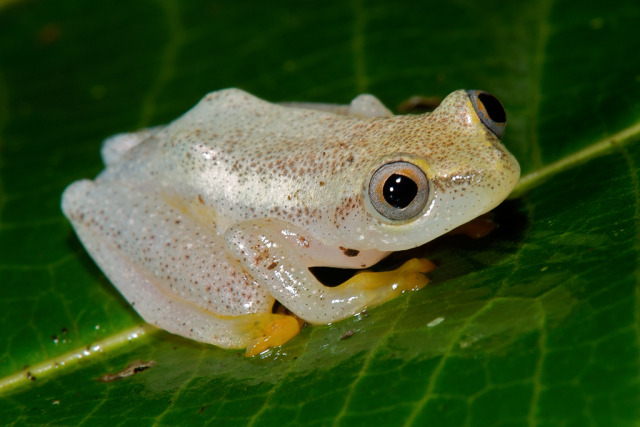
Heterixalus boettgeri
Heterixalus boettgeri is a species of frog in the Hyperoliidae family. It is endemic to Madagascar and is found in the extreme southeast and south of the island. The specific name Boettgeri honors the German zoologist Oskar Boettger. The common name is Boettger's reed frog.
Habitat and nature conservation
This species occurs in a range of habitats at elevations below 300 m asl: Dry forests, 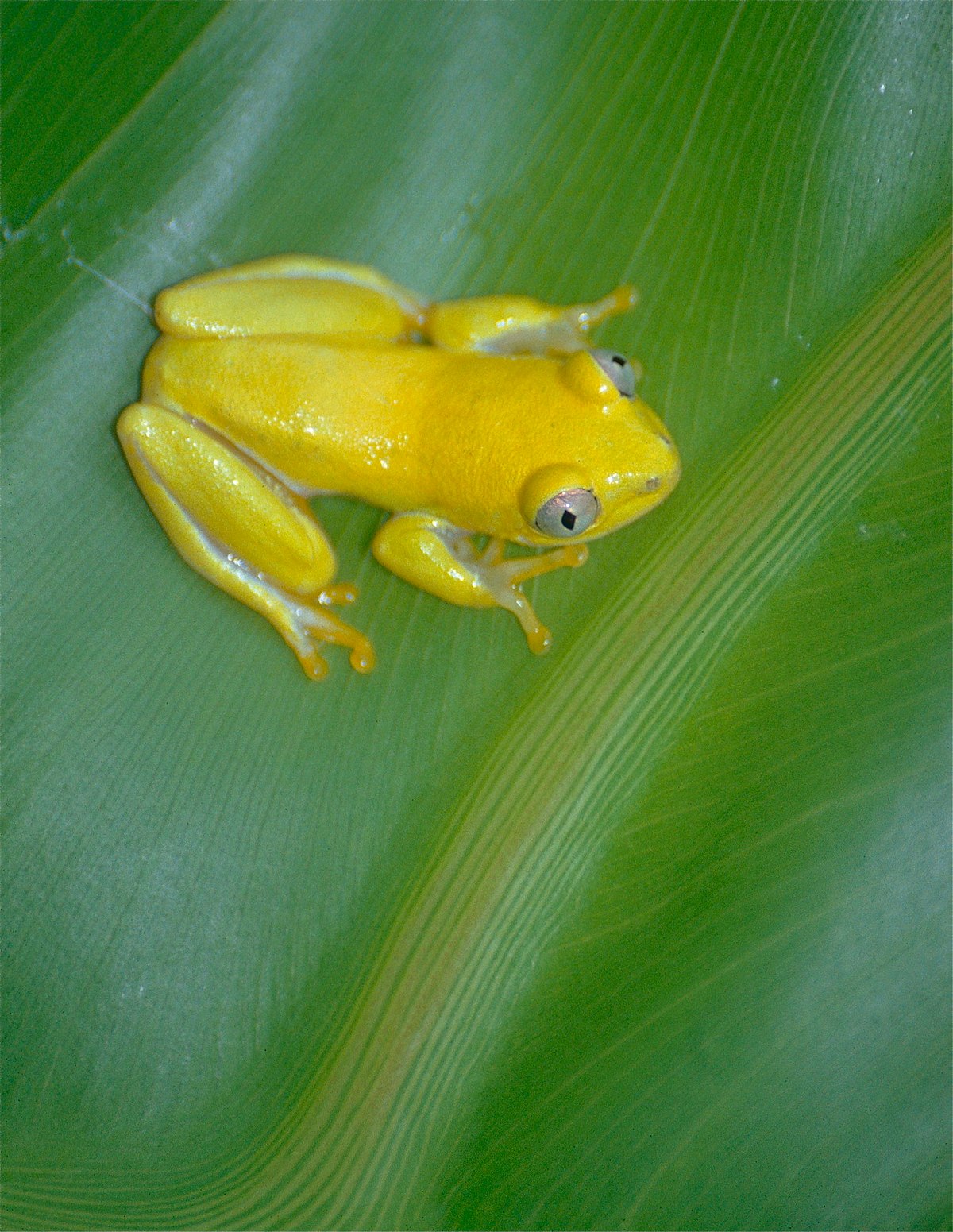
Males call after night rains in sun-exposed swamps and rice fields. This is a locally common and adaptable species that is unlikely to face any major threats.
It is found in small numbers in the international pet trade.
It occurs in some protected areas (Cape Sainte Marie Special Reserve, Mandena Classified Forest), possibly also in the Andohahela National Park.
Heterixalus carbonei
Heterixalus carbonei is a species of frog in the family Hyperoliidae endemic to Madagascar. Its natural habitats are subtropical or tropical dry forests, subtropical or tropical moist lowland forests, freshwater swamps and intermittent freshwater swamps. It is threatened with habitat loss.
Heterixalus luteostriatus
Heterixalus luteostriatus is a species of frog of the Hyperoliidae family endemic to Madagascar. Its natural habitats are subtropical or tropical dry forests, swamps, freshwater marshes, intermittent freshwater marshes, farmlands, urban areas, heavily degraded former forests, ponds, irrigated areas and seasonally flooded agricultural areas.
Heterixalus madagascariensis
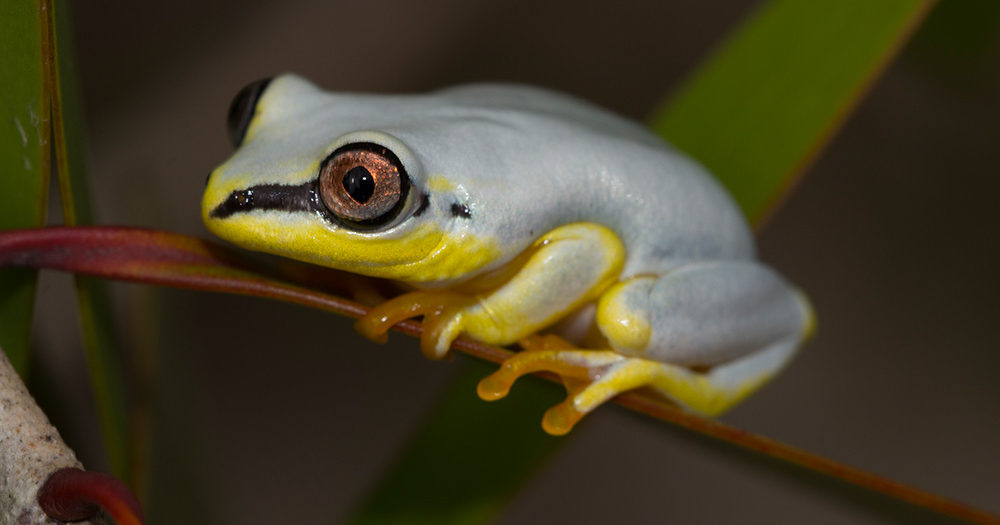
Its natural habitats are subtropical or tropical dry forests, subtropical or tropical moist lowland forests, moist savanna, subtropical or tropical seasonally moist or flooded lowland grasslands, swamps, freshwater marshes, intermittent freshwater marshes, sandy shores, farmlands, urban areas, severely degraded former forests, ponds, irrigated lands, and seasonally flooded agricultural lands.
It is a popular choice of amphibians in pet stores because of its beautiful colors and ease of care in a neat setup.
Heterixalus punctatus
Heterixalus punctatus is a species of frog endemic to Madagascar, belonging to the family Hyperoliidae. Its natural habitats are subtropical or tropical moist lowland forests, swamps, freshwater marshes, intermittent freshwater marshes, farmland, rural gardens, severely degraded former forests, ponds, irrigated land and seasonally flooded agricultural land.
Heterixalus rutenbergi
Heterixalus rutenbergi is a species of frog in the Hyperoliidae family endemic to Madagascar.
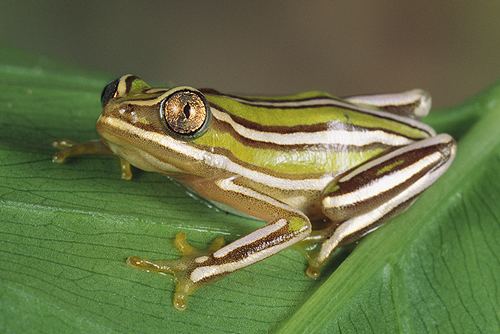
They are severely threatened by habitat loss.
The back surface of this frog is light green.
It has five white bands bordered by dark brown stripes running lengthwise along its back. On the sides of the limbs are two similar bands, and one along the feet.
The ventral surface is cream, and the underside of the limbs is orange.
Heterixalus tricolor
Heterixalus tricolor is a species of frog in the Hyperoliidae family endemic to Madagascar.
Its natural habitats are subtropical or tropical dry forests, wet savanna, subtropical or tropical seasonally wet or flooded lowland grasslands, swamps, freshwater marshes, intermittent freshwater marshes, cropland, severely degraded former forests, ponds, irrigated lands, seasonally flooded agricultural lands, and canals and ditches.
Heterixalus variabilis
Heterixalus variabilis is a species of frog in the family Hyperoliidae endemic to Madagascar. Its natural habitats are wet savanna, subtropical or tropical, seasonally wet or flooded lowland grassland, swamps, freshwater marshes, intermittent freshwater marshes, farmland, urban areas, heavily degraded former forests, ponds, irrigated land, seasonally flooded agricultural land, and canals and ditches.
Mantellidae
Systematics
The family Mantellidae is composed of three ecologically extremely diverse groups of frogs, divided into three subfamilies:
Mantellinae, are typically terrestrial or semi-aquatic frogs;
Laliostominae are terrestrial, typically quite large-sized frogs;
Boophinae are tree frogs.
As of May 3, 2016, 212 species are recognized in this family.
However, DNA barcoding research has shown that more than 100 different genetic lineages remain taxonomically undescribed.
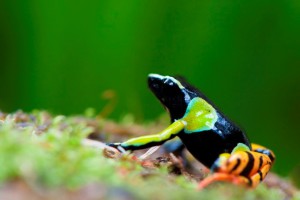
Evolution and island biogeography
The Mantellidae are the most species-rich frog family of Madagascar.
It has been shown that there is a negative correlation between body size and species diversity in this family, probably related to the lower dispersal potential of smaller animals.
This family is estimated to have colonized the island of Madagascar 76-87 million years ago.
They are phylogenetically embedded in Asian frogs and therefore likely represent a dispersal event from Asia.[
Two undescribed species of mantled frogs are currently native to Mayotte Island off the west coast of Madagascar.
These species belong to two genera that are otherwise exclusively endemic to Madagascar: They are genetically distinct from all mainland species and await formal description.
Reproduction
Reproductive modes in the Mantellidae vary widely.
Eggs may be laid in or out of the water, on the bottom or on leaves, depending on the genus and species.
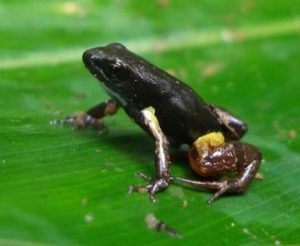
Some types of Gephyromantis Have direct development or nidicolous tadpoles. Members of the subfamilies Boophinae and Laliostominae have an amplexus, but the mantle line frogs do not.
Parental care is known from a few species (e.g. Mantidactylus argenteus). Sexual size dimorphism is present in most species, with females larger than males, but there are exceptions (e.g. Boophis albilabris) where males are larger than females, possibly due to males fighting for access to females.
Aglyptodactylus australis
Is a rare species of frog from the family of Mantellidae.
It is endemic to Madagascar, and its natural habitats are subtropical or tropical moist lowland forest, subtropical or tropical moist montane forest, subtropical or tropical upland grassland, swamps, and highly degraded former forest.
It is threatened by habitat loss.
Aglyptodactylus chorus
Is a rare species of frog from the family of Mantellidae.
It is endemic to Madagascar, and its natural habitats are subtropical or tropical moist lowland forest, subtropical or tropical moist montane forest, subtropical or tropical upland grassland, swamps, and highly degraded former forest.
It is threatened by habitat loss.
Aglyptodactylus laticeps
Aglyptodactylus laticeps is a species of frog in the family Mantellidae.
It is endemic to Madagascar, and its natural habitats are subtropical or tropical dry forests and intermittent freshwater swamps.
It is threatened by the loss of its habitat.
Aglyptodactylus madagascariensis
Aglyptodactylus madagascariensis is a species of frog in the family Mantellidae, commonly known as the Madagascar jumping frog.
It is endemic to Madagascar, where it is found far over the eastern side of the island's
is widespread.
This frog is widespread and forms large groups during its mating season when it breeds "explosively".
It lives in the fallen leaves.
Aglyptodactylus securifer
Aglyptodactylus securifer is a species of frog in the family Mantellidae.
It is endemic to Madagascar, where it lives in forests.
This species was described only in 1998.
Their upper sides are colored silver-gray to beige with gray bands on the legs. The undersides are yellow and the belly is white.
The eyes are golden yellow with black pupils.
Blommersia angolafa
Blommersia angolafa is a species of frog in the family Mantellidae.
This recently described species is endemic to eastern Madagascar.
The specific epithet derives from the term "angolafa" or "angolafo", the Malagasy vernacular name given to the Betsimisaraka for the palm species Dypsis palm (mostly for Dypsis lastelliana) used, whose leaves and prophylls are the habitat for this frog.
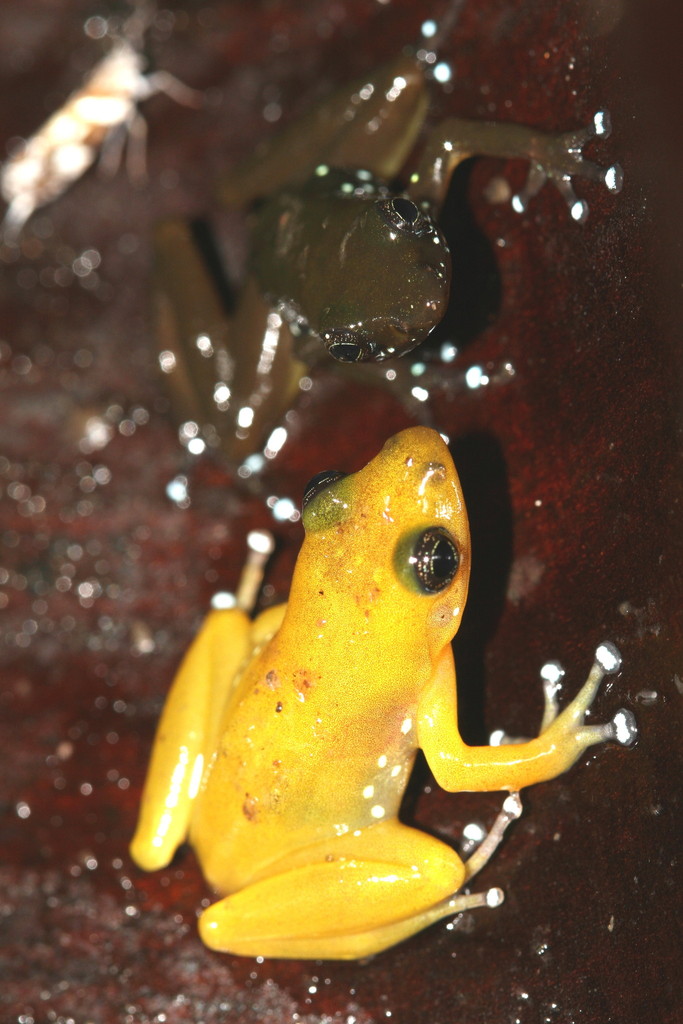
Blommersia angolafa is a small frog with a body size of 17-21 mm, with enlarged tips on fingers and toes and without dark areas in the tympanum and toes as found in the other Blommersia.
Blommersia angolafa has fairly uniform dorso-lateral coloration, shading from yellowish light brown to dark brown, with light bluish spots on the flanks and light bluish terminal parts of the fingers and toes.
The species also appears to be chromatically sexually dimorphic.
In fact, the males are distinguished from the females by a light coloration, while the females are more brownish.
Blommersia angolafa is similar to B. grandisonae.
Although both Blommersia angolafa and Blommersia. grandisonae have enlarged fingertips, these are much more developed in B. angolafa.
Eggs and tadpoles
Egg clutches are not found until December; they are glued to the inner walls of dead prophylls of palms filled with water and fallen to the ground.
There are several different stages of tadpoles that share the water that has accumulated in the same fallen prophyll.
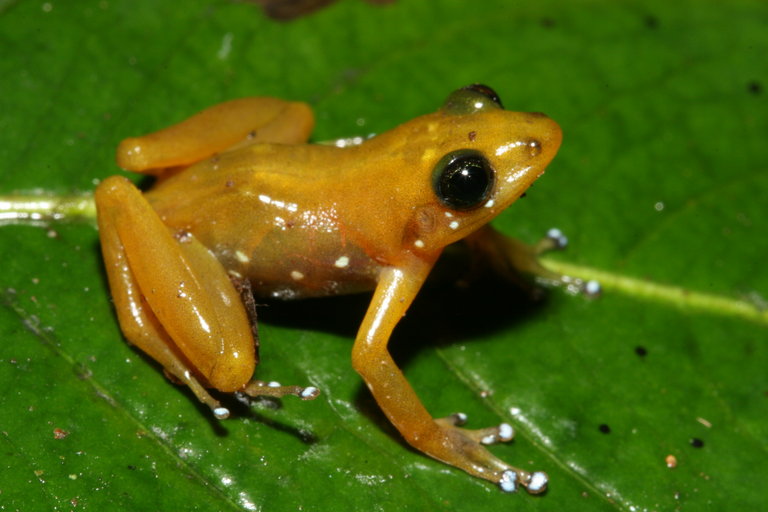
Blommersia angolafa occurs in four forest blocks in eastern Madagascar: Masoala, Ambatovaky, Zahamena and Betampona and takes rainforest with a height difference between 90 m (Ankavanana River, Masoala Peninsula) and 508 m (Vohitsivalana, RNI de Betampona) on.
It occurs in both primary and secondary forest, as some Dypsis palms are tolerated by Betampona in secondary rainforest.
The observed height distribution on Betampona ranged from 332-548 m a.s.l. Andreone et al. suggest that this species may also occur at other rainforest sites located at these altitudes and latitudes in eastern Madagascar, such as. Makira and Mananara North.
Life history, activity and special behaviors
A special aspect that characterizes this species is its novel life history and reproductive mode.
Both sexes live and breed in a phytotelm habitat of water accumulated in the fallen prophylls and leaf sheaths of at least three species of dypsispalms.
Within these phytotelmata, oviposition and full larval development occur. Andreone et al. never observed individuals outside dead fallen Dypsis phytotelmata that were on the forest floor or contained rainfall.
Blommersia dejongi
Is a rare species of frog from the family of Mantellidae.
It is endemic to Madagascar, and its natural habitats are subtropical or tropical moist lowland forest, subtropical or tropical moist montane forest, subtropical or tropical upland grassland, swamps, and highly degraded former forest.
It is threatened by habitat loss.
Blommersia galani
Is a rare species of frog from the family of Mantellidae.
It is endemic to Madagascar, and its natural habitats are subtropical or tropical moist lowland forest, subtropical or tropical moist montane forest, subtropical or tropical upland grassland, swamps, and highly degraded former forest.
It is threatened by habitat loss.
Blommersia variabilis
Is a rare species of frog from the family of Mantellidae.
It is endemic to Madagascar, and its natural habitats are subtropical or tropical moist lowland forest, subtropical or tropical moist montane forest, subtropical or tropical upland grassland, swamps, and highly degraded former forest.
It is threatened by habitat loss.
Blommersia domerguei
Blommersia domerguei is a species of frog in the family Mantellidae.
It is endemic to Madagascar, and its natural habitats are subtropical or tropical moist lowland forest, subtropical or tropical moist montane forest, subtropical or tropical upland grassland, swamps, and highly degraded former forest.
It is threatened by habitat loss.
Blommersia grandisonae
Blommersia grandisonae is a species of frog in the family Mantellidae, first described in 1974 by Jean Marius René Guibé was described.
It is endemic to Madagascar.
Its natural habitats are subtropical or tropical moist lowland forests, rivers, intermittent freshwater swamps, and plantations.
It is threatened by the loss of its habitat.
Blommersia kely
Blommersia kely is a species of frog in the family Mantellidae.
It is endemic to Madagascar. Its natural habitats are subtropical or tropical wet montane forests, wet savannahs, subtropical or tropical upland grasslands, swamps and highly degraded former forests.
It is threatened by the loss of its habitat.
Blommersia sarotra
Blommersia sarotra is a species of frog in the family Mantellidae.

It is threatened by the loss of its habitat.
Species characteristics
Blommersia sarotra exhibit the typical characteristics of a single subgular vowel sac, short hands, and an elongate head, like most other species of the genus Blommersia.
However, distinguishing characteristics of the species Blommersia sarotra include the presence of a white patch on the neck, the absence of vomerine teeth, and a unique mating call consisting of a long pulsed tone followed by a click.
Blommersia wittei
Blommersia wittei is a species of frog in the family Mantellidae.
These frogs from Madagascar are endemic.
Its natural habitats are subtropical or tropical moist lowland forests, dry savanna, wet savanna, swamps, freshwater marshes, intermittent freshwater marshes, plantations, rural gardens, highly degraded former forests, and ponds.
Boehmantis microtympanum
Boehmantis is a genus of frog in the subfamily Mantellinae.
It is monotypic and is represented by a single species, Boehmantis microtympanum, represents.

Boehmantis microtympanum was originally introduced by Fernand Angel in the Genus Mantidactylus described.
The species was transferred to its own genus, Boehmantis, by Frank Glaw and Miguel Vences.
Distribution and habitat
This species is in the Midongy du sud National Park and in the Andohahela National Park endemic to southeastern Madagascar.
Their natural habitats are rivers and streams within subtropical or tropical moist lowland forests, subtropical or tropical moist montane forests, and degraded forest.
Conservation status
Boehmantis microtympanum is currently considered vulnerable by the IUCN due to its limited range and ongoing habitat destruction.
Boophis albilabris
The White-lipped Bright-Eyed Frog (Boophis albilabris) is a species of frog in the family Mantellidae.
It is endemic to Madagascar.
Its natural habitats are subtropical or tropical moist lowland forests, subtropical or tropical moist montane forests, rivers, intermittent streams, and severely degraded former forests.
It is threatened by the loss of its habitat.
Boophis albipunctatus
Boophis albipunctatus is a species of frog in the family Mantellidae. It is endemic to Madagascar.
Its natural habitats are subtropical or tropical moist lowland forests and rivers. It is threatened by habitat loss.
However, it is not on the endangered species list.
Boophis andohahela
Boophis andohahela is a species of frog in the family Mantellidae.

Its natural habitats are subtropical or tropical moist lowland forests, subtropical or tropical moist montane forests, and rivers.
It is protected in its currently known ranges, but if it exists outside of them, it may be threatened by habitat loss from agriculture, logging, charcoal production, invasive eucalyptus trees, grazing livestock, and expanding human settlements.
.
Boophis andrangoloaka, Boophis andreonei
Boophis andreonei and Boophis andrangoloaka is a species of frog in the family Mantellidae. It is endemic to Madagascar. Its natural habitats are subtropical or tropical moist lowland forests and rivers. It is threatened by habitat loss.
Boophis anjanaharibeensis
Boophis anjanaharibeensis is a species of frog in the family Mantellidae.
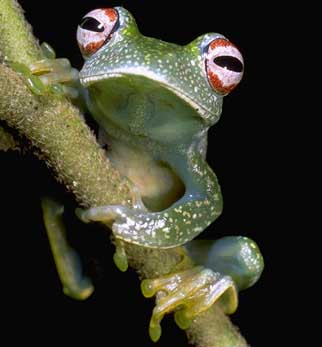
Its natural habitats are subtropical or tropical moist lowland forests, subtropical or tropical moist montane forests, and rivers.
It is threatened by habitat loss to agriculture, logging, charcoal production, invasive eucalyptus trees, grazing livestock, and expanding human settlements.
Boophis ankaratra
Boophis ankaratra is a species of frog in the family Mantellidae. It is endemic to Madagascar.
Its natural habitats are subtropical or tropical moist montane forests, rivers, grasslands, rural gardens, and heavily degraded former forests.
It is threatened by the loss of its habitat.
Boophis arcanus
Boophis arcanus is a species of frog in the family Mantellidae. It is endemic to Madagascar. This species does not show sexual dimorphism.
Boophis axelmeyeri
Boophis axelmeyeri is a species of frog in the family Mantellidae. It is endemic to Madagascar.
He is after the Evolutionary biologist and zoologist Axel Meyer named
Boophis baetkei
Boophis baetkei is a species of frog in the family Mantellidae.

It is a tree species found in a highly disturbed transitional forest (also characterized as a relatively dry rainforest).
It is threatened by severe habitat loss occurring in the area of its type locality.
Boophis blommersae
Boophis blommersae is a species of frog in the family Mantellidae.
He is in the North Madagascar endemic and known from two sites, Montagne d'Ambre and near Tsaratanana.
There is also a newer one from the Near Bemanevika.
The specific name blommersae honors Rose Marie Antoinette Blommers castles, a Dutch herpetologist and entomologist.
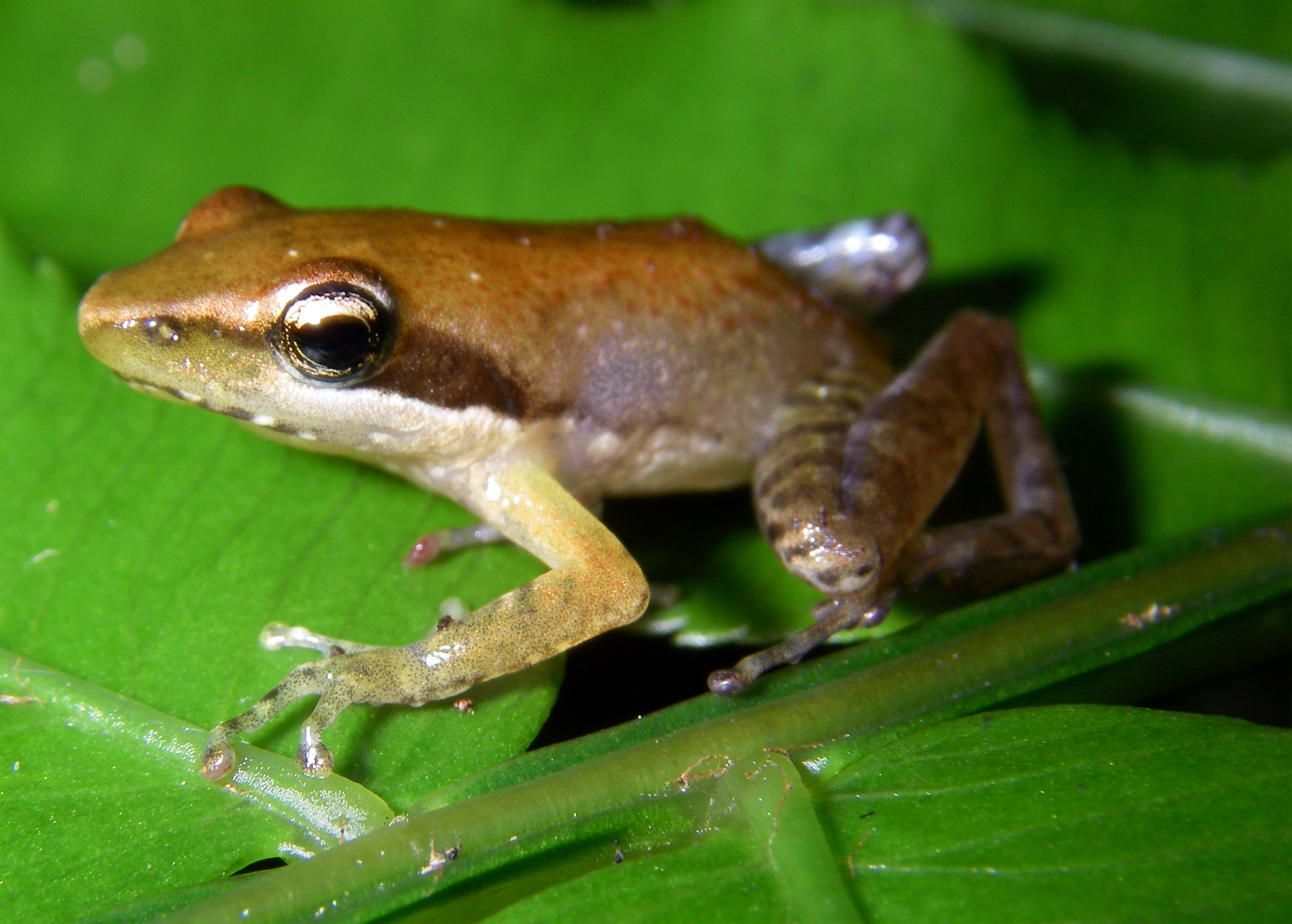
Adult males measure 24-27 mm in length. The fingers have some webbing, while the toes are stronger. The dorsal skin is smooth. Dorsal coloration is highly variable: uniform light brown, brown with a large dark hourglass pattern, or brown with lichen-like yellow or pink spots.
The throat is transparent with a green shading, while the belly is silvery white centrally and transparent laterally.
The iris is light brown to gray, with some reddish-brown color and greenish-yellow periphery.
The legs have rather indistinct dark transverse bands. The tips of the fingers and toes are greenish.
The iris is light brown to gray.
Habitat and nature conservation
Boophis blommersae occurs in moist rainforest at elevations of 379-1,780 m above sea level.
The tadpoles develop in streams.
It is a very common species, but tolerates little habitat change - it is threatened by habitat loss caused by subsistence agriculture, logging, charcoal production, the spread of eucalyptus, and the expansion of human settlements.
However, it comes in the well-managed National Park Montagne d'Ambre and in the Tsaratanana Reserve as well as in the planned Bemanevika Sanctuary before.
Boophis boehmei
Boophis boehmei is a species of frog in the family Mantellidae. It is endemic to Madagascar. Its natural habitats are subtropical or tropical moist lowland forests, subtropical or tropical moist montane forests and rivers. It is threatened by habitat loss.
Boophis boppa
Is a rare species of frog from the family of Mantellidae.
It is endemic to Madagascar, and its natural habitats are subtropical or tropical moist lowland forest, subtropical or tropical moist montane forest, subtropical or tropical upland grassland, swamps, and highly degraded former forest.
It is threatened by habitat loss.
Boophis bottae
Boophis bottae is a species of frog in the family Mantellidae endemic to Madagascar.
Distribution and habitat
The species inhabits the eastern rainforest belt of Madagascar at altitudes of 800-1,000 m.
It occurs along forest streams, where it presumably breeds, and is found on the edge of, but never entirely outside, rainforest[.

At Andasibe-Mantadia National Park Boophis bottae is found.
B. bottae is locally abundant and is currently considered of least concern by the IUCN.
However, populations are believed to be declining due to ongoing habitat destruction from agriculture, logging, charcoal, and various invasive species.
Other species in this genus have shown susceptibility to chytridiomycosis, but this does not appear to affect amphibians in Madagascar at this time.
Boophis brachychir
Boophis brachychir is a species of frog in the family Mantellidae.

Its natural habitats are subtropical or tropical dry forests, subtropical or tropical moist lowland forests, subtropical or tropical moist montane forests, moist savanna, rivers, and highly degraded former forests.
It is threatened by habitat loss to agriculture, logging, charcoal production, invasive eucalyptus trees, grazing livestock, fire, and expanding human settlements.
It is often associated with Boophis madagascariensis confused.
There are no known conservation measures, but it occurs in protected areas.
Boophis calcaratus
Boophis calcaratus (sometimes also the Bright-eyed Frog called) is a species of tree frog found in Madagascar.
It has large tubercles on the heels, which are especially conspicuous in females and distinguish it from most other Boophis species; among tuberculate Boophis, it is distinguished by the absence of webbing on the hands.
Boophis doulioti
Boophis doulioti is a species of frog in the family Mantellidae. It is endemic to Madagascar.
Its natural habitats are subtropical or tropical dry forest, dry savanna, wet savanna, subtropical or tropical dry shrubland, subtropical or tropical wet shrubland, swamps, temporary freshwater marshes, grasslands, seasonally flooded agricultural lands, and canals and ditches.
Frog from Madagascar - Boophis elenae
Boophis elenae is a species of frog in the family Mantellidae. It is endemic to Madagascar, only from the Ranomafana National Park (where it is abundant) and the Farimazava Forest in Antoetra known.

It is threatened by habitat loss to agriculture, logging, charcoal production, invasive eucalyptus trees, grazing livestock, and expanding human settlements.
Boophis entingae
Is a rare species of frog from the family of Mantellidae.
It is endemic to Madagascar, and its natural habitats are subtropical or tropical moist lowland forest, subtropical or tropical moist montane forest, subtropical or tropical upland grassland, swamps, and highly degraded former forest.
It is threatened by habitat loss.
Boophis erythrodactylus
Boophis erythrodactylus is a species of frog in the family Mantellidae.
It is endemic to Madagascar.
Its natural habitats are subtropical or tropical moist lowland forests, subtropical or tropical moist montane forests, and rivers.
It is threatened by the loss of its habitat.
Frog from Madagascar - Boophis fayi
Boophis fayi is a nocturnal skeleton frog species endemic to the forests and wetlands of Madagascar or Madagascar with unusual greenish eyes.
It is classified as endangered by the International Union for Conservation of Nature.
Taxonomy
Boophis fayi is a member of the B. goudoti group in the genus of large skeleton frogs.
He was born in 2011 together with another frog, Boophis popi, described.
The two were found to be closely related by molecular phylogenetics.
Description
Boophis fayi was first found in the Betampona Reserve in Madagascar found
Skeleton frogs are identified primarily by their eyes, and B. fayi has a greenish rather than red iris color and is characterized by green outer irises and turquoise iris peripheries.
It also has a barely perceptible supratympanic fold in males.
The frog has an intercalary element between the last and penultimate fingers and toes, bridal pads, and males do not have female glands, so it belongs to the genus Boophis.
It is brown in color and has skin flaps on heels and elbows and white tubercles along the cloacal opening, so it can be assigned to the B. goudoti group.
The species has a relatively small SVL (snout vent length) compared to the rest of the B. goudoti group and is further characterized by its unique eye color, small white warts in the cloacal area, and a weak supratypanic fold.
It also exhibits considerable genetic differentiation from the rest of the group.
Compared to frogs of similar size, it has a unique iris and does not exhibit increased dorsal reticulation.
Compared to larger frogs, males have a slightly larger SVL and shorter hindlimbs.
Behavior
The frog can also be distinguished by its song, which consists of a series of 1-3 notes with a duration of 100-370 ms.
The tones pulse, but the pulse repetition is fast.
The sound repetition rate is about 3.3/s. It also has another call, which is called "call" because of its similarity to that of B. tampoka is assumed to be a territorial call. These are 1-2 click notes with a duration of up to 200 ms, depending on the number of notes.
The tones do not pulse and the tone repetition is about 6-10/s. These series are separated by irregular intervals.
Distribution and habitat
Boophis fayi is found in the lowland rainforests and wetlands of central eastern and northeastern Madagascar.
Conservation status
According to the IUCN Red List, the population is endangered and declining; threats include development, livestock, fire, invasive species, and logging.
Their conservation status has not been assessed by any other source.
Boophis feonnyala
Boophis feonnyala is a species of frog in the family Mantellidae.

He is in the National Park protected, but if it occurs elsewhere, it may be threatened by agriculture, logging, charcoal production, invasive eucalyptus trees, livestock grazing, and expanding human settlements.
Its natural habitats are subtropical or tropical moist lowland forests, rivers, freshwater lakes, heavily degraded former forests, and water storage areas.
Boophis goudotii
Boophis goudotii (common name: Goudot's bright-eyed frog) is a species of frog in the family Mantellidae, endemic to Madagascar, where it is widely distributed on the plateau of central Madagascar.
Records elsewhere are uncertain, and many of them represent misidentifications.
It is the only Malagasy frog known to be voiced by females.

The specific name Goudotii honors Jules Prosper Goudot, a French collector who was active in Madagascar in the first half of the 19th century.
Description
Males measure 50-70 mm and females typically 75-87 mm, but they can grow up to 100 mm.
Coloration is variable, from almost completely blackish to yellowish with black spots.
The ventral area is yellowish or orange and may have blackish spots.
The iris is coppery turquoise at the periphery.
The tympanum is distinct. The males have bridal setae and a subgular vocal sac.
Calls include irregularly emitted moans that sound during the day and night, they are made by both sexes.
Habitat and nature conservation
Boophis goudotii is a common species found in rainforests, fields, and disturbed riverbanks near slow-moving or standing water.
Its altitude range is 900-2,200 m above sea level.
They are poor climbers, but are sometimes found in trees.
Breeding occurs in both permanent and temporary bodies in slow-moving or stagnant water.
While the forest habitat of this species is retreating, it tolerates a wide range of habitats.
It is also collected for human consumption, but not in quantities that would pose a threat.
Boophis guibei
Boophis guibei, sometimes known as the warty button-eyed frog, is a species of frog in the family Mantellidae. It is endemic to Madagascar
Its natural habitats are subtropical or tropical moist lowland forests, rivers, freshwater swamps, intermittent freshwater marshes, and severely degraded former forests. It is threatened with habitat loss.
Frog from Madagascar Boophis haematopus
Boophis haematopus is a species of frog in the family Mantellidae.
It is endemic to Madagascar. Its natural habitats are subtropical or tropical moist lowland forests and rivers. It is threatened by habitat loss.
Boophis haingana
Is a rare species of frog from the family of Mantellidae.
It is endemic to Madagascar, and its natural habitats are subtropical or tropical moist lowland forest, subtropical or tropical moist montane forest, subtropical or tropical upland grassland, swamps, and highly degraded former forest.
It is threatened by habitat loss.
Frog from Madagascar Boophis idae
Boophis idae (Ida's bright-eyed frog) is a species of frog from the family Mantellidae. It is endemic to Madagascar.
The species is widespread in the eastern humid lowlands and montane rainforests of Madagascar, from Nosy Boraha down to Ivohibe, at altitudes of 900-1,100 m.
It also resides in swamps, marshes, and a variety of wet habitats used by humans. It appears to be locally common throughout its range.
Nature Conservation
Although the species is currently classified as a least concern by the IUCN, it is believed to be impacted by habitat loss due to agriculture, logging, charcoal production, and the spread of invasive species such as eucalyptus trees.
Boophis jaegeri
Boophis jaegeri, also called the Green Skeleton Frog, is a species of frog in the family Mantellidae. It is endemic to Madagascar. Its natural habitats are subtropical or tropical moist lowland forests, rivers, plantations and severely degraded former forests. It is threatened by habitat loss.
Boophis laurenti
Boophis laurenti is a species of frog in the family Mantellidae. It is endemic to Madagascar and known only from Andringitra National Park. Its natural habitats are subtropical or tropical moist montane forests, subtropical or tropical tall shrublands, subtropical or tropical tall grasslands, and rivers. It is threatened by habitat loss to fires and livestock grazing.
Boophis liami
Boophis liami is a species of frog in the family Mantellidae.

Its natural habitats are subtropical or tropical moist lowland forests, rivers, and severely degraded former forests.
It is threatened by habitat loss to agriculture, logging, charcoal production, invasive eucalyptus trees, livestock grazing, and the spread of human settlements.
Boophis lichenoides, Boophis lilianae, Boophis luciae
Are rare frog species from the family of Mantellidae.
They are all endemic to Madagascar, and their natural habitats are subtropical or tropical moist lowland forest, subtropical or tropical moist montane forest, subtropical or tropical upland grassland, swamps, and highly degraded former forest.
Like all Mantellidae, they are threatened by habitat loss.
Boophis luteus
Boophis luteus is a species of frog in the family Mantellidae.
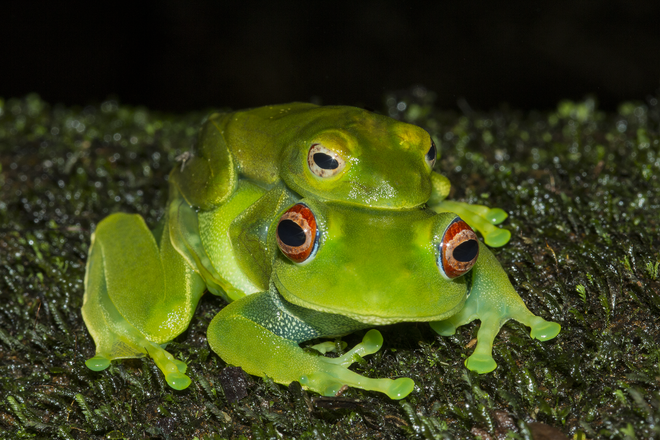
It is threatened by the loss of its habitat.
Boophis luteus has a snout-vent of 35-60 mm in length; males 35-40 mm, a female 51 mm. Their belly is bluish to greenish, and the skin on the back is smooth.
Boophis madagascariensis
Boophis madagascariensis is a species of frog in the family Mantellidae. It is endemic to Madagascar.
Its natural habitats are subtropical or tropical moist lowland forests, subtropical or tropical moist montane forests, rivers, freshwater marshes, intermittent freshwater marshes, and severely degraded former forests.
It is threatened by the loss of its habitat.
Boophis majori
Boophis majori is a species of frog in the family Mantellidae. It is endemic to Madagascar. Its natural habitats are subtropical or tropical moist lowland forests, subtropical or tropical moist montane forests and rivers.
They are threatened with habitat loss.
Boophis mandraka
Boophis mandraka is a species of frog in the family Mantellidae.

Its natural habitats are subtropical or tropical moist montane forests, rivers, and heavily degraded former forests.
It is threatened by habitat loss for agriculture, logging, charcoal production, invasive eucalyptus trees, livestock grazing, and the spread of human settlements.
Boophis marojezensis
Boophis marojezensis is a species of frog in the family Mantellidae.
It is endemic to Madagascar.
Its natural habitats are subtropical or tropical moist lowland forests and rivers. It is threatened by habitat loss.
Frog from MadagascarBoophis miadana
Is a rare species of frog from the family of Mantellidae.
It is endemic to Madagascar, and its natural habitats are subtropical or tropical moist lowland forest, subtropical or tropical moist montane forest, subtropical or tropical upland grassland, swamps, and highly degraded former forest.
It is threatened by habitat loss.
 Boophis microtympanum
Boophis microtympanum
Boophis microtympanum is a species of frog in the family Mantellidae.
It is endemic to Madagascar. Its natural habitats are subtropical or tropical wet montane forest, wet savanna, subtropical or tropical upland grassland, rivers and highly degraded former forest. It is threatened with habitat loss.
Boophis miniatus
Boophis miniatus is a species of frog in the family Mantellidae.
It is endemic to Madagascar. Its natural habitats are subtropical or tropical moist lowland forests, rivers and heavily degraded former forests.
It is threatened by the loss of its habitat.
Boophis narinsi
Is a rare species of frog from the family of Mantellidae.
It is endemic to Madagascar, and its natural habitats are subtropical or tropical moist lowland forest, subtropical or tropical moist montane forest, subtropical or tropical upland grassland, swamps, and highly degraded former forest.
It is threatened by habitat loss.
Boophis obscurus
Is a rare species of frog from the family of Mantellidae.
It is endemic to Madagascar, and its natural habitats are subtropical or tropical moist lowland forest, subtropical or tropical moist montane forest, subtropical or tropical upland grassland, swamps, and highly degraded former forest.
It is threatened by habitat loss.
 Boophis occidentalis
Boophis occidentalis
Boophis occidentalis is a species of frog in the family Mantellidae. It is endemic to Madagascar. Its natural habitats are subtropical or tropical dry forests, rivers, grasslands, urban areas and highly degraded former forests. It is threatened by habitat loss.
Boophis opisthodon
Boophis opisthodon is a species of frog in the family Mantellidae. It is endemic to Madagascar.
Its natural habitats are subtropical or tropical dry forests, subtropical or tropical moist lowland forests, swamps, freshwater marshes, intermittent freshwater marshes, and severely degraded former forest.
Boophis pauliani
Boophis pauliani is a species of frog in the family Mantellidae.
It is endemic to Madagascar.
Its natural habitats are subtropical or tropical moist lowland forests, subtropical or tropical moist montane forests, rivers, swamps, temporary freshwater marshes, cropland, pastureland, and severely degraded former forest.
It is threatened by the loss of its habitat.
Boophis periegetes
Boophis periegetes is a species of frog in the family Mantellidae.
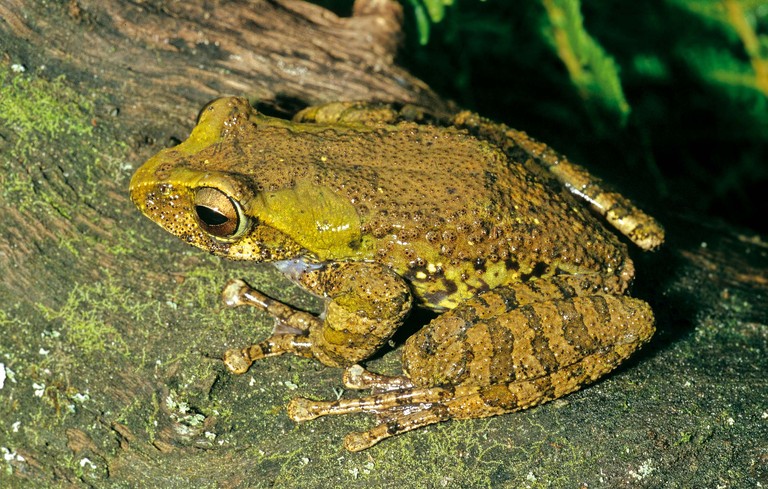
Its natural habitats are subtropical or tropical moist lowland forests, subtropical or tropical moist montane forests, and rivers.
It is threatened by habitat loss for agriculture, logging, charcoal production, invasive eucalyptus trees, livestock grazing, and the spread of human settlements.
Boophis picturatus
Boophis picturatus is a species of frog in the family Mantellidae. It is endemic to Madagascar.
Its natural habitats are subtropical or tropical moist lowland forests and rivers. It is not considered threatened by the IUCN.
Boophis piperatus
Is a rare species of frog from the family of Mantellidae.
It is endemic to Madagascar, and its natural habitats are subtropical or tropical moist lowland forest, subtropical or tropical moist montane forest, subtropical or tropical upland grassland, swamps, and highly degraded former forest.
It is threatened by habitat loss.
Boophis popi
Boophis popi is a species of nocturnal skeleton frog endemic to the forests of Madagascar, distinguished by its red irises and distinct raised webs on its back. It is brown and gray, has slender limbs, has a pulsating call, and is slightly larger than similar frogs in its genus. The species was described in 2011 and is named after the company "pop-interactive GmbH".
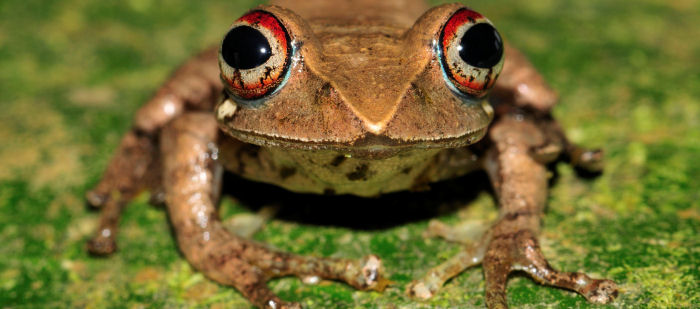
It was described by Jörn Köhler, Frank Glaw, Gonçalo M. Rosa, Philip-Sebastian Gehring, Maciej Pabijan, Franco Andreone and Miguel Vences in their 2011 paper titled "Two new bright-eyed tree frogs of the genus Boophis from Madagascar" and named after the German company "pop-interactive GmbH", which supported the research and conservation of the biodiversity.
Molecular genetic studies have established a close relationship with Boophis fayi and Boophis boehmei.
B. popi has distinct bright red outer iris, beige inner iris (with a brown vascular pattern) surrounded by a black ring, with blue border in the iris periphery.
The frog is brown in color with several black and beige spots on its body, and the flanks also have brown and yellow spots.
The throat and chest are beige and gray, and the belly is light brown with small brown spots.
The limbs are gray with brown patterns.
Preserved specimens tend to have a lighter color. The throat and chest are smooth, the belly is granular, and the cloaca is surrounded by white warts.
The arms are somewhat slender, the forearms are fringed, and there is a pointed skin appendage at the elbow. The fingers follow a length pattern of, with the second finger being significantly shorter than the fourth.
The second finger is much shorter than the fourth. It has slender hind limbs as well as a dermal appendage at the heel. He has five toes that follow the length pattern.
The females are larger than the males.
Although it appears to be morphologically similar to the other frogs in Boophis, there are some key differences that make B. popi a different species. Visually, B. popi is most similar to B. axelmeyeri, but it is smaller in size
Compared to B. rufioculis, B. popi has smaller cloacal tubercles and shorter hindlimbs. B. popi also has distinctly raised reticulations on the back, while similar frogs do not. It is placed in the genus Boophis because of the intercalary element between the last two fingers and toes, the nupital setae, and the absence of female glands in the male.
Behavior
- popi is a nocturnal tree frog and is active on vegetation near slow-moving streams during the rainy season.
- Popi calls contain two short series of pulsating tones, one with three tones and the other with two tones.
The duration of the notes varies from 18-29 ms and the pauses between notes range from 97-120 ms.
Its pitch is similar to that of B. boehmei and B. quasiboehmei, but is somewhat lower, as the larger body size suggests.
However, the calls of those of the B. goudoti group are very similar and not unique to B. popi in particular.
Habitat and distribution
B. popi is found in montane rainforest in central Madagascar.
Its population is declining, and common threats include development, agriculture, mining, logging, fire, and invasive species and diseases.
Boophis praedictus, Boophis pyrrhus, Boophis quasiboehmei, Boophis rappiodes, Boophis reticulatus, Boophis rhodoscelis, Boophis roseipalmatus, Boophis rufioculis, Boophis sambirano, Boophis sandrae, Boophis schuboeae, Boophis septentrionalis, Boophis sibilans

All are endemic to Madagascar, and its natural habitats are subtropical or tropical moist lowland forest, subtropical or tropical moist montane forest, subtropical or tropical upland grassland, swamps, and highly degraded former forest.
They are threatened by habitat loss.
Boophis spinophis, Boophis tampoka, Boophis tasymena, Boophis tephraeomystax, Boophis tsilomaro, Boophis ulftunni, Boophis viridis, Boophis vittatus, Boophis williamsi,
are rare frog species from the family of Mantellidae.
All are endemic to Madagascar, and its natural habitats are subtropical or tropical moist lowland forest, subtropical or tropical moist montane forest, subtropical or tropical upland grassland, swamps, and highly degraded former forest.
They are threatened by habitat loss.
Boophis xerophilus
Boophis xerophilus is a species of frog endemic to Madagascar in the family Mantellidae, found only in the Kirindy Forest in the central west of Madagascar and the Réserve Naturelle Privée de Berenty in extreme southeastern Madagascar is known; it may also be more widespread between the two known locations.
Its natural habitats are subtropical or tropical dry forests, moist savanna and intermittent freshwater swamps.
It is threatened by habitat loss to agriculture, logging, charcoal production, livestock grazing, fires, and expanding human settlements.
Genus Laliostoma
Laliostoma labrosum
Laliostoma is a genus of frog in the family Mantellidae.

Its natural habitats are subtropical or tropical moist lowland forests, dry savanna, wet savanna, subtropical or tropical dry shrubland, subtropical or tropical dry lowland grassland, intermittent freshwater swamps, hot deserts, cropland, pastureland, rural gardens, urban areas, ponds, seasonally flooded agricultural land, and canals and ditches.
Mantella aurantiaca
The Golden Mantella (Mantella aurantiaca) is a small terrestrial frog endemic to Madagascar.

Mantella aurantiaca is one of the most threatened amphibian species in Madagascar, due to its limited distribution in an area under enormous anthropogenic pressure.
It may also be threatened by overcollection for the pet trade.
Description
The golden mantella is a uniform yellow, orange or red frog with a size of 20-26 mm. The inner limb has red lightning marks. The tympanum is visible but small. It is believed that the bright colors of the golden mantella are an example of aposematism and warn predators of the frog's toxicity.
Ecology and behavior
The golden mantella is highly seasonal in its behavior and remains largely inactive during the winter months of May-October.
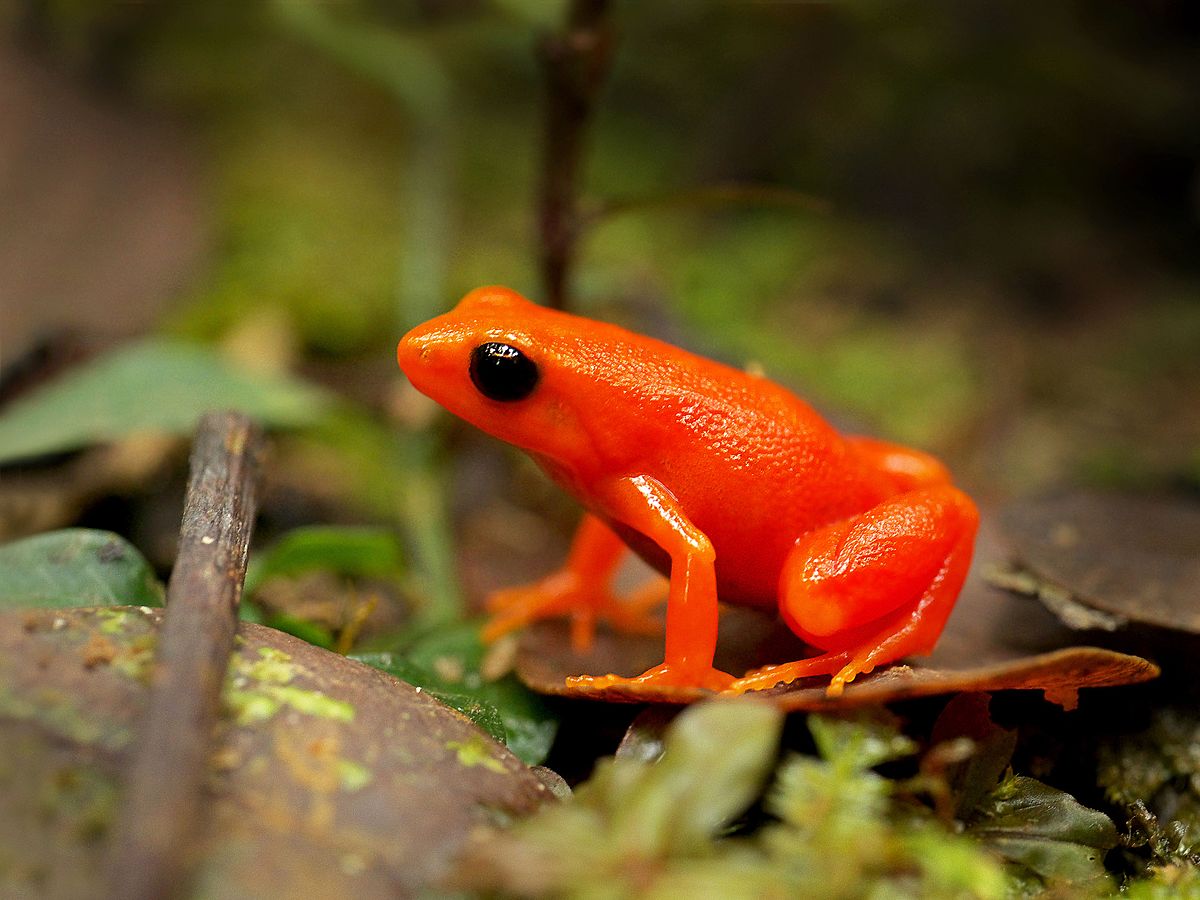
Males often call from hidden positions near a water source.
The call is a rather pleasant, repetitive click.
The frogs do not appear to move into the typical amplexus, but the male only moves in a virtual amplexus over the female's back.
Eggs are laid in moist leaf litter near water on land, and when rain arrives, the tadpoles are washed from the land into the water.
The golden mantella feeds on small invertebrates. in the wild this consists mainly of mites, ants, flies and collembolans The frogs obtain their skin toxins from their food.
These toxins include pumiliotoxin, allopumiliotoxin, homopumiliotoxin alkaloids, pyrrolizidines, indolizidines, and quinolizidines.
Although venomous, the snake Thamnosophis lateralis and a skink of the genus Zonosaurus have been observed hunting this species in the Torotorofotsy wetland.
In captivity
There are plans to start a legally regulated collection program for this species.
The golden mantella is occasionally seen in the pet trade and kept in captivity by exotic animal collectors and zoological institutions. They are popular for their daily activity, attractive coloration, and relative ease once settled in.
Etymology
The species was discovered by the French Herpetologist François Mocquard described in 1900 on the basis of a 21.2 mm long male individual.
The species was found in forests in the area between Beforana and Moramanga.
The species name comes from the Latin aurantiacus, which means gold.
Mantella baroni
Mantella baroni (often known by the common names of. Baron's mantella, the colorful golden frog, or the Madagascar poison frog) is a species of small poison frog from the family Mantellidae.

Distribution, habitat and conservation status
Like other species in Mantellidae, this taxon is endemic to Madagascar.
This family is estimated to have colonized the island of Madagascar 76-87 million years ago, evolving in the island's isolation and adapting in geographic range and number of species on the island.
Mantellidae are phylogenetically related to Asian frogs and therefore likely represent a dispersal event from Asia.
It is one of about 220 frog species (including 15 in Mantella) endemic only to Madagascar.
It has a medium-sized elongated geographic Distribution area in east central Madagascar, which stretches from the east coast inland and from north to south, from Fierenana in the south until Andringitra ranges.

It typically prefers to stay at altitudes between 600-1200 meters above sea level.
Although classified as a species of Least Concern by the IUCN as of 2016, its population trends are technically unknown due to its relatively wide distribution, and it may be threatened by various sources of habitat loss.
These include anthropogenic encroachment through commercialization and industrialization, timber and logging, and agriculture.
It is listed in Appendix II of CITES.
Description
Although this species is only 28-32 mm long at maturity, it is one of the largest in the genus of 16 species, dwarfed only by a few individuals of Mantella viridis.
Most individuals of this species have specific, unique characteristics that distinguish them from other Mantella species.
However, there are a variety of phenotypes manifested in forelimb colors ranging from bright green to vivid oranges and yellows that are sometimes confused or introduced into the international market as Mantella cowanii.

These spots "contrast with the black dorsum and conspicuous orange and black legs" in both species, making it difficult for dealers, sellers, herpetologists, breeders, collectors and pet owners to acquire the correct species.
The easiest way to distinguish the two species is to note the "sky-blue, horseshoe-shaped markings" on the throat of the painted Mantella and the lack of "lightning marks on the lower hind limbs" on the Baron's Mantella. Because of its similar appearance, the Baron's Mantella is sometimes informally referred to as the "painted Mantella," although the painted Mantella is a distinct species overall.
Bernhard's mantella (Mantella bernhardi), brown mantella (Mantella betsileo) , Cowan's mantella (Mantella cowanii), yellow mantella or eastern mantella (Mantella crocea), Mantella ebenaui
Are rare frog species from the family of Mantellidae.
All are endemic to Madagascar, and its natural habitats are subtropical or tropical moist lowland forest, subtropical or tropical moist montane forest, subtropical or tropical upland grassland, swamps, and highly degraded former forest.
They are threatened by habitat loss.
Mantella expectata
The blue-legged mantella (Mantella expectata) is a small frog species from the family of Mantellidae. It is found in the Isalo National Park and endemic to areas south of it in Madagascar, a range it shares with the Rainbow frog (Scaphiophryne gottlebei) shares
Both are locally common, but endangered due to habitat loss and over-collected for the pet trade.
Habitat and behavior
The blue-legged Mantella is diurnal and belongs to the species group of the M. betsileo.
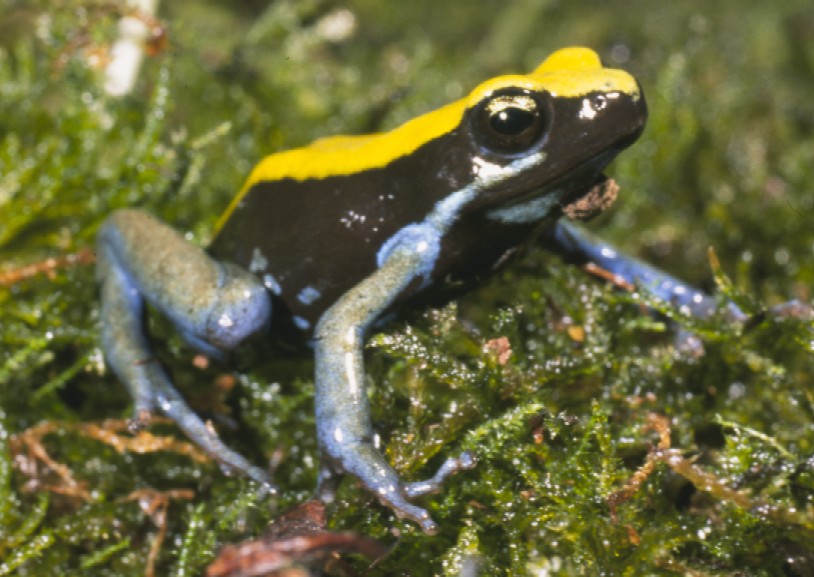
Their breeding season is from September to December.
The eggs are either hung on the walls of ravines or laid under rocks. Then they are flooded by water and complete their development in temporary pools.
It is a fairly short-lived species with a typical maximum age of 3 years.
Appearance
The so-called "desert mantella", a probably undescribed species closely related to the blue-legged mantella
The blue-legged Mantella has a length of 2-3 cm, it is quite distinctive with aposematic colors, a warning of the alkaloid toxins in its skin.
The back and top of the head are yellow, contrasted by blue legs and black flanks and sides of the head.
The underside is black with blue spots. There are individual and locality variations, with some having darker and grayer legs or, in the very north of their range, a reddish lower back (contrasting with the yellow upper back and upper head)
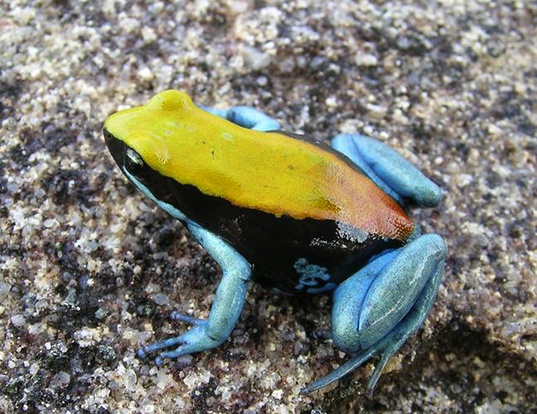
In the south of the species' range, individuals usually have some brown on the legs, which is close to the appearance of brown Mantella (M. betsileo), and some are genetically intermediate between the two species, but their taxonomic position is still unclear.
This intermediate population is sometimes referred to as M. cf. expectata, while the so-called "desert Mantella," a probably undescribed species from arid habitats in southernmost and western Madagascar that is closely related to the blue-legged Mantella, is sometimes referred to as M. Aff. expectata
The sex of blue-legged Mantella can be determined by the size of the body (females are on average significantly larger than males), in males by a horseshoe-shaped blue spot on the lower jaw, and by vocal characters emitted specifically by males only.
Mantella haraldmeieri, Mantella laevigata
Mantella haraldmeieri, Mantella laevigata are rare frog species from the family Mantellidae.
All are endemic to Madagascar, and its natural habitats are subtropical or tropical moist lowland forest, subtropical or tropical moist montane forest, subtropical or tropical upland grassland, swamps, and highly degraded former forest.
They are threatened by habitat loss.
Mantella madagascariensis
Mantella madagascariensis, common names Malagasy painted mantella, Malagasy mantella, Malagasy golden frog, Malagasy mantella and painted mantella, is a species of frog in the family Mantellidae.
 Distribution
Distribution
This species is endemic to Madagascar. It occurs in east-central Madagascar in the highlands from near Niagarakely in the south until Ranomafana occurs at an altitude of 700-1,050 m above sea level. It is threatened by habitat loss and may be threatened by commercial collection.
Habitat
Its natural habitats are subtropical or tropical moist lowland forests, subtropical or tropical moist montane forests, and rivers.
Description
Mantella madagascariensis can reach a body length of 21-22 millimeters in males and 24-25 millimeters in females. These tiny but powerful frogs are quite variable in color and pattern, being irregularly striped black and yellow.
Normally they have a blackish body, but the back is usually black. A green or yellowish rostral stripe runs along the head.
Femur and humerus are usually yellow to green, while thigh, tarsus, and foot are reddish-orange with blackish spots.
The yellow-green spots extend to the flanks near the forelimbs.
This species is closely related to Mantella pulchra related and Mantella baroni very similar.
Amphibians from Madagascar - Mantella viridis
The Green Mantella (Mantella viridis) is a species of frog from the family Mantellidae. It is endemic to Madagascar.

Commercial trade in these species requires strict regulation so as not to threaten them.
Description
Green Mantella is a small frog. Males are 22-25 mm, females 25-30 mm.
The species is widely distributed in the pet trade as a vivarium species.
Some of the frogs have a more yellow color, the head is black with a white band around the upper lip. The underside of the frog is black with blue speckles.
The female species is predominantly larger and has a more square snout. They are threatened with extinction due to habitat loss and overcollection for the pet trade.
Habitat
Green Mantella live in the far north of Madagascar and thrive in dry lowland forests at elevations between 50 and 300 meters above sea level.
Nutrition
Insects, Invertebrates, they also eat soft fruits. Green Mantella need water, like most frogs, but they do not get it by drinking. Their permeable skin allows them to absorb the water.
Mantidactylus albofrenatus
Mantidactylus albofrenatus is a species of frog in the family Mantellidae. It is endemic to eastern Madagascar near An'Ala and Andasibe.
The common name eastern Madagascar frog has been proposed for it.
 Description
Description
Adult males measure 19-23 mm (0.7-0.9 in) and adult females 25-27 mm (1.0-1.1 in.
The legs are short. The tympanum is large in males, larger than the eye. The males have distinct female glands. The toes have rudimentary bands. Dorsal coloration is brown, forming a distinct dorsolateral color boundary with the dark brown flanks.
A distinct light stripe runs from the base of the forelimb to (almost) the nostril. The throat is dark gray with a distinct pattern of white spots forming a central row. The hind limbs have dark transverse bands.
The male commercial is a rapid series of 31-36 short pulsed tones.
Habitat and nature conservation
Mantidactylus albofrenatus is an earth frog that occurs in pristine or only slightly disturbed rainforests at elevations of 850-900 m (2,790-2,950 ft) above sea level.
It is often found near streams. Calling males have been found near streams during the day. The eggs are presumably laid on land.
It is a locally common species, but only occurs at two sites, and its population is believed to be declining due to ongoing habitat loss and degradation. It occurs in the Analamazaotra Special Reserve before.
Mantidactylus charlotteae
Mantidactylus charlotteae is a species of frog in the family Mantellidae. It is endemic to Madagascar and occurs in the eastern part of the country in the coastal rainforest belt between Marojejy in the north and possibly as far as Andohahela in the south.
 Description
Description
Males measure 22-26 mm (0.87-1.02 in) and females 26-32 mm (1.0-1.3 in. The body is relatively slender. The head is long with a rounded snout. The eardrum is prominent. The limbs are slender. The fingers are without webbed fingers, while the toes are webbed.
The back is reddish brown in color and without markings. There are reddish dorso-lateral glandular ridges. The flanks are blackish, with a sharp edge towards the back.
Habitat and nature conservation
Its natural habitats are pristine or lightly disturbed rainforests at elevations up to 600 m (2,000 ft) above sea level.
It is a terrestrial species, often found near streams. It breeds in streams, but lays its eggs on land.
Mantidactylus charlotteae is a very common species, although it is thought to be declining due to habitat loss and degradation.
These threats are caused by agriculture, logging, charcoal, the spread of eucalyptus, livestock grazing, and the expansion of human settlements. However, it occurs in several protected areas.
Mantidactylus tricinctus
Mantidactylus tricinctus is a species of frog in the family Mantellidae.
Distribution and habitat
This species is endemic to Madagascar.
It is found between 450 and 850 m altitude in three locations in the east and southeast of the island: An'Ala, Befotaka and Vondrozo.
Its natural habitats are subtropical or tropical moist lowland forests, rivers and swamps. It is threatened by habitat loss.
Description
Mantidactylus tricinctus is 17 to 19 mm long. Its back is brown with darker spots.
The species is characterized by a yellow spot on the groin and a white spot on the tip of the snout.
Spinomantis aglavei
Spinomantis aglavei is a species of frog in the subfamily Mantellinae, endemic to Madagascar.
Habitat and ecology
This species occurs in subtropical or tropical moist lowland forests, subtropical or tropical moist montane forests, rivers, and swamps.
It is threatened by the loss of its habitat.
Spinomantis bertini
Spinomantis bertini is a species of frog in the subfamily Mantellinae, endemic to Madagascar.
 Distribution and habitat
Distribution and habitat
S. bertini has a relatively wide distribution in southeastern Madagascar, at elevations of 500-1,300 m (1,600-4,300 ft) above sea level.
It inhabits crevices between boulders and rocky areas, usually near streams, in pristine forest habitats; the species does not occur in degraded forests or secondary growth.
Nature Conservation
The species is classified as Near Threatened by the IUCN. It is under pressure from habitat loss due to expansion of agriculture, timber and coal production, and settlements, as well as the spread of invasive plants such as eucalyptus.
Spinomantis brunae
Spinomantis brunae (common name: Bruna's brook frog) is a species of frog in the family Mantellidae. It is endemic to Madagascar and known from the Anosy Mountains in southeastern Madagascar.
 Description
Description
Males measure 32-35 mm (1.3-1.4 in) . The females are unknown.
The back is olive green with a reticulated pattern of dark brown spots.
The flanks have white spots. The pads of the fingers and toes bear a pair of white spots. The iris is creamy white. The tympanum is distinct.
The body is granular dorsally, with weakly granular flanks and abdomen. The fingers and toes bear enlarged, triangular discs. Males have a subgular vocal sac.
Scpinomantis brunae
Scpinomantis brunae occurs in virgin forests at elevations of 600-800 m (2,000-2,600 ft) above sea level.

Their breeding habitat is unknown, but it may be flowing water; one male was observed calling up a branch a foot above the ground through a small stream.
This species has a moderate local distribution. However, the frog is threatened by habitat loss caused by subsistence agriculture, deforestation and growing human settlements.
It comes in the Andohahela National Park before.
Spinomantis elegans
Spinomantis elegans is a species of frog in the mantleid subfamily Mantellinae that is endemic to Madagascar.
 Distribution and habitat
Distribution and habitat
S. elegans occurs only in southeastern Madagascar, with uncertain records from northern Madagascar.
It has been recorded at elevations of 1,350-2,500 m, where it inhabits subtropical or tropical moist montane forests and grasslands, always in association with rocky areas.
They breed in streams.
Nature Conservation
The species appears to be rare, and males have never been collected.
It is currently classified as Near Threatened by the IUCN.
Their forest habitat is constantly shrinking due to anthropogenic influences. S. elegans occurs in several protected areas.
Spinomantis fimbriatus
Spinomantis fimbriatus is a species of frog in the mantellid subfamily Mantellinae that is endemic to Madagascar.
 Taxonomy
Taxonomy
This species was described in 1994 by Glaw & Vences in the genus Mantidactylus, subgenus Spinomantis.
Habitat and distribution
The species is endemic to Madagascar.
It was created by Andasibe in the east Madagascar over the North to Masoala, Anjanaharibe and Marojejy detected in the northeast of Madagascar.
Its natural habitats are pristine subtropical or tropical moist lowland forests at altitudes of 500-1,000 m..
Nature Conservation
Although S. fimbriatus is currently considered of least concern by the IUCN due to its abundant populations throughout its range, the species is likely under some pressure from the loss of its forest habitat to agriculture, settlements, and wood and charcoal production, as well as the spread of invasive plants such as eucalyptus.
Spinomantis peraccae
Spinomantis peraccae is a species of frog in the subfamily Mantellinae. It is endemic to Madagascar and widespread in the northern, eastern and central parts of the island.
The specific epithet honors the Italian Herpetologist Mario Giacinto Peracca. The Malagasy frog of Peracca was named after him.
 Description
Description
Adult males measure 34-44 mm (1.3-1.7 in) and adult females 39-45 mm (1.5-1.8 in) in snout-vent length. The snout is rounded. The tympanum is prominent and the supra-tympanic fold is prominent.
The fingers have expanded discs, but no webbing; the toes have webbing, but the discs are smaller than those on the fingers. The dorsum is brownish-greenish and has darker spots.
The dorsal skin is rather warty with dark, protruding spots. The lower parts are whitish; there are only a few dark spots on the neck.
Geographical scope
It is endemic to the eastern half of Madagascar.
Habitat
Spinomantis peraccae occurs in pristine rainforests along streams at elevations of 500-2,000 m (1,600-6,600 ft) above sea level.
It lives on trees.
The eggs are laid on leaves above water. The tadpole develops in slow flowing streams.
Conservation status
Spinomantis peraccae is a locally abundant species, but it is suffering from habitat loss. It occurs in many protected areas. Because of its wide range and large overall population, it is not considered threatened.
Spinomantis phantasticus
Spinomantis phantasticus is a species of frog in the family Mantellidae. It is endemic to east-central and northeastern Madagascar.
 Description
Description
Spinomantis phantasticus males measure 36-38 mm (1.4-1.5 in) in snout-vent length.
This is a very conspicuous species, with a distinctive green-brown dorsal pattern and large spines all over the body.
Both the ventral side and the femoral glands are greenish.
The male ad call is a sequence of 4 or 5 "metallic" double-click notes.
Scpinomantis brunae
Scpinomantis brunae occur along streams in pristine forests at elevations of 500-1,200 m (1,600-3,900 ft) above sea level. It probably breeds in streams, like other species of the genus.
Males call from about 2-4 m above the ground in vegetation along streams.
This species is locally abundant.
However, subsistence agriculture, logging, charcoal production, spread of invasive eucalyptus, livestock grazing, and expanding human settlements pose threats to their habitat.
It comes in the National Parks Masoala and Marojejy before.
Spinomantis tavaratra
Spinomantis tavaratra is a species of frog in the subfamily Mantellinae. It is endemic to the humid forests of northwestern Madagascar.
Taxonomy
This species was described in 2008 by Cramer, Rabibisoa, and Raxworthy in the genus Spinomantis.
The species name tavaratra is a Malagasy word for "the north" and refers to the origin of this species in northern Madagascar.
 Description
Description
Adult males measure 30.5-36.0 mm (1.20-1.42 in); females measure 31.6-33.2 mm (1.24-1.31 in).
The species is also characterized by simple dermal spines less than 1 mm (0.039 in) long on the posterior margin of the tarsus.
Habitat and ecology
Its natural habitats are primary forest near streams at an altitude of 650-1,300 m above sea level, in the Marojejy National Park, but also on the Sorata Massif.
It is a tree-dwelling species that breeds in streams.

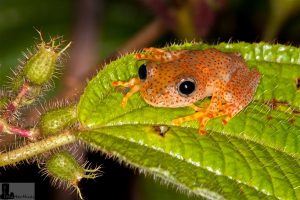

 Boophis microtympanum
Boophis microtympanum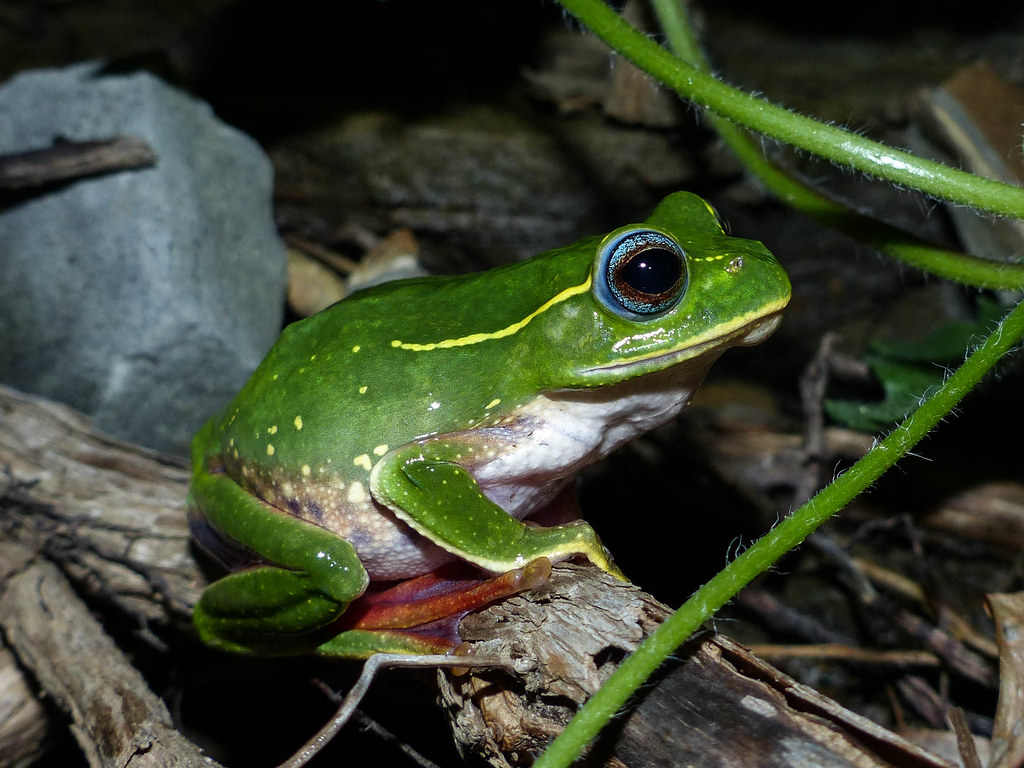 Boophis occidentalis
Boophis occidentalis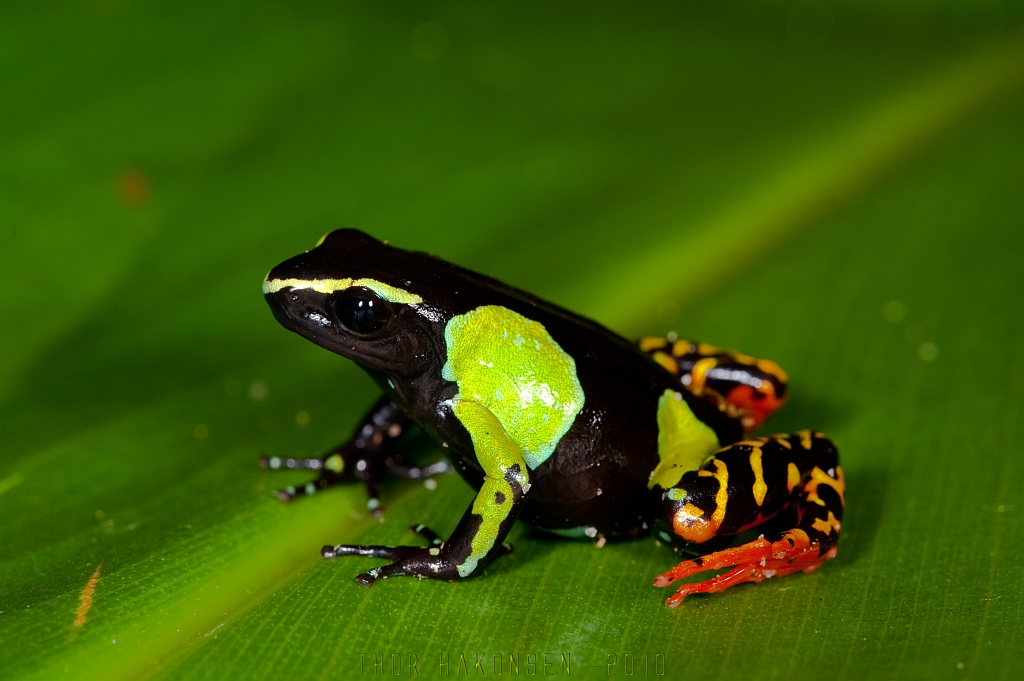 Distribution
Distribution Description
Description Description
Description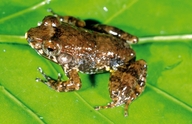
 Distribution and habitat
Distribution and habitat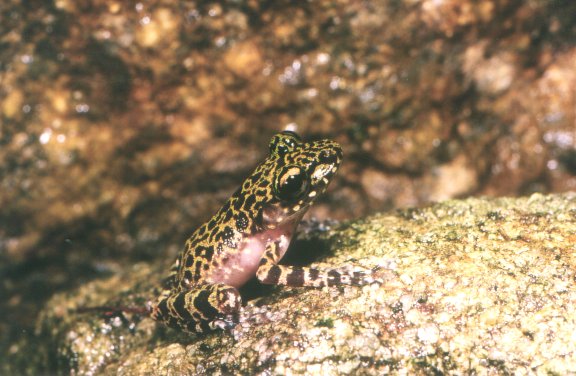 Description
Description Distribution and habitat
Distribution and habitat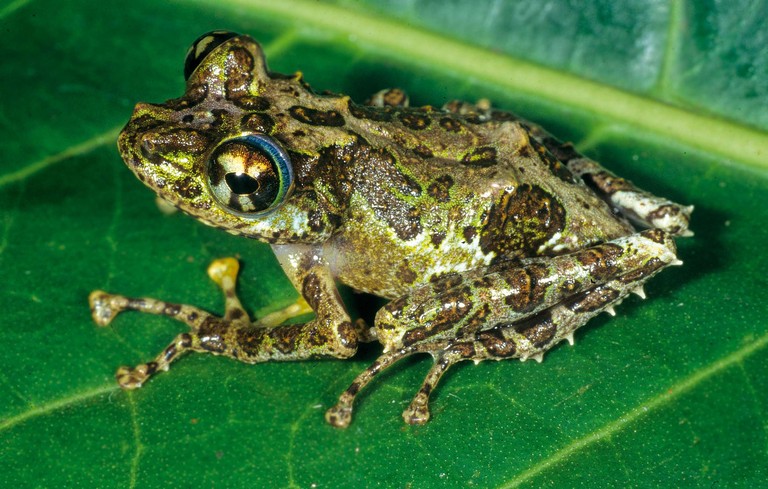 Taxonomy
Taxonomy Description
Description Description
Description Description
Description

